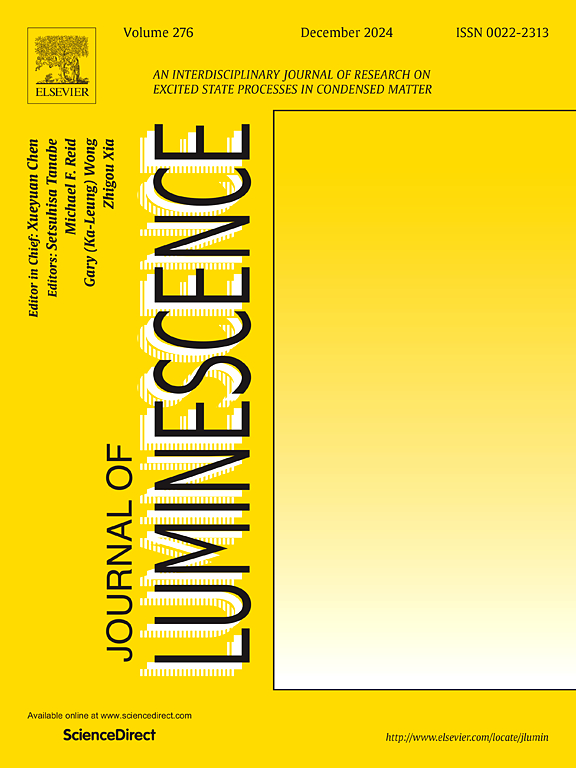Li+诱导WLED应用中Eu3+→Eu2+还原和掺eu的KAlSi2O6荧光粉的光致发光性能的增强
IF 3.3
3区 物理与天体物理
Q2 OPTICS
引用次数: 0
摘要
wled已经彻底改变了现代照明技术,但探索高质量的nuv激发荧光粉仍然是一个重大挑战。在此,我们提出了一种Li+共掺杂策略来调节Eu价态并增强硅酸盐基荧光粉的发光性能。采用固相反应法制备了一系列[K1-xLix]AlSi2O6: 0.02Eu (x = 0-0.08)荧光粉。XRD和XPS分析表明,Li+离子优先占据KAlSi2O6晶格中的K+位,削弱K- o键能,促进Eu3+→Eu2+还原。在365 nm激发下,KAlSi2O6: 0.02Eu呈现出较宽的Eu2+相关发射带(400 ~ 600 nm)和两个较窄的Eu3+相关峰(593和612 nm)。Li+离子的加入抑制了Eu3+的发射,增强了Eu2+的发射,在x = 0.06处达到峰值。此外,[K0.94Li0.06]AlSi2O6: 0.02Eu表现出优异的热稳定性(423 K时85.45%),色度偏移可以忽略(293-463 K时ΔE = ~ 0.0022),这归因于其高结构刚度和单发射中心。用[K0.94Li0.06]AlSi2O6: 0.02Eu制备的WLED具有较高的显色指数(Ra = 90.4)和适中的相关色温(CCT = 4536 K)。这些发现不仅突出了[K0.94Li0.06]AlSi2O6: 0.02Eu作为人类中心wled蓝色荧光粉的潜力,而且为提高硅酸盐中Eu3+→Eu2+还原效率提供了策略。本文章由计算机程序翻译,如有差异,请以英文原文为准。
Li+ induced enhancements in Eu3+→Eu2+ reduction and photoluminescence properties of Eu-doped KAlSi2O6 phosphors for WLED applications
WLEDs have revolutionized modern lighting technologies, but the exploration of high-quality NUV-excited phosphors remains a significant challenge. Herein, we propose a Li+ co-doping strategy to regulate Eu valence states and enhance luminescence properties in silicate-based phosphors. A series of [K1-xLix]AlSi2O6: 0.02Eu (x = 0–0.08) phosphors are successfully synthesized via a solid-state reaction method. XRD and XPS analyses reveal that Li+ ions preferentially occupy the K+ sites in the KAlSi2O6 lattice, weakening K-O bonding energy and facilitating the Eu3+→Eu2+ reduction. Under 365 nm excitation, KAlSi2O6: 0.02Eu exhibits a broad Eu2+-related emission band (400–600 nm) and two narrow Eu3+-related peaks (593 and 612 nm). Incorporation of Li+ ions quenches Eu3+ emissions and enhances Eu2+ emission, peaking at x = 0.06. Moreover, [K0.94Li0.06]AlSi2O6: 0.02Eu demonstrates excellent thermal stability (85.45 % at 423 K) with negligible chromaticity shift (ΔE = ∼0.0022 in 293–463 K), attributed to its high structural rigidity and single emitting center. A WLED fabricated with [K0.94Li0.06]AlSi2O6: 0.02Eu achieves a high color rendering index (Ra = 90.4) and a moderate correlated color temperature (CCT = 4536 K). These findings not only highlight the potential of [K0.94Li0.06]AlSi2O6: 0.02Eu as a blue phosphor for human-centric WLEDs, but also provide a strategy for enhancing Eu3+→Eu2+ reduction efficiency in silicates.
求助全文
通过发布文献求助,成功后即可免费获取论文全文。
去求助
来源期刊

Journal of Luminescence
物理-光学
CiteScore
6.70
自引率
13.90%
发文量
850
审稿时长
3.8 months
期刊介绍:
The purpose of the Journal of Luminescence is to provide a means of communication between scientists in different disciplines who share a common interest in the electronic excited states of molecular, ionic and covalent systems, whether crystalline, amorphous, or liquid.
We invite original papers and reviews on such subjects as: exciton and polariton dynamics, dynamics of localized excited states, energy and charge transport in ordered and disordered systems, radiative and non-radiative recombination, relaxation processes, vibronic interactions in electronic excited states, photochemistry in condensed systems, excited state resonance, double resonance, spin dynamics, selective excitation spectroscopy, hole burning, coherent processes in excited states, (e.g. coherent optical transients, photon echoes, transient gratings), multiphoton processes, optical bistability, photochromism, and new techniques for the study of excited states. This list is not intended to be exhaustive. Papers in the traditional areas of optical spectroscopy (absorption, MCD, luminescence, Raman scattering) are welcome. Papers on applications (phosphors, scintillators, electro- and cathodo-luminescence, radiography, bioimaging, solar energy, energy conversion, etc.) are also welcome if they present results of scientific, rather than only technological interest. However, papers containing purely theoretical results, not related to phenomena in the excited states, as well as papers using luminescence spectroscopy to perform routine analytical chemistry or biochemistry procedures, are outside the scope of the journal. Some exceptions will be possible at the discretion of the editors.
 求助内容:
求助内容: 应助结果提醒方式:
应助结果提醒方式:


